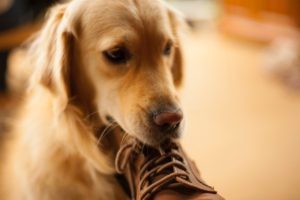Doggie Footwear
 Winter in the Northeast can be brutal. Nor’easters, ice storms and knee-high slush are tough enough for we humans to navigate on foot. But what about our beloved four-legged friends?
Winter in the Northeast can be brutal. Nor’easters, ice storms and knee-high slush are tough enough for we humans to navigate on foot. But what about our beloved four-legged friends?
Even though I’m not originally from Clifton Park, I did grow up in New York’s Capital District so I’m pretty well-versed in how harsh our winters can be.
It got me to thinking about how tough this season can be on our canine companions. So I started searching for ways to make things easier for them when the impending storms arrive.
Toeing the Line
All of the Dogs of Winter, including the teams that lead the Alaskan Iditarod, and rescue dogs who don’t take time off during inclement weather and rocky treks are always fitted for boots. One might try to argue that these are extreme cases, however I’m not alone in believing every poochs’ pads deserves some TLC.
Helen Fazio, a writer for Dogster.com, is aligned with my kind of thinking. Check out her article titled So You Think Dogs Don’t Need Boots here at http://www.dogster.com/lifestyle/dog-boots.
Boots can safeguard your pup’s feet from the cold and prevent pads from cracking. Imagine how often a dog’s feet are exposed to toxic road and sidewalk salt during and after a snowstorm. And what about the fact that boots (and a coat) can actually keep your four-legged friend warm when the mercury dips below freezing?
Veterinarian Laura Brown of Green Tree Animal Hospital in Liberty, Illinois recently shared her expertise on the matter online at https://player.fm/series/bark-n-wag-15-minute-vet-talk/veterinarians-tips-on-protecting-your-dogs-nose-and-paws-this-winter.
Among other things, Brown recommended avoiding areas that may contain de-icing products and the propensity dogs’ paws have for developing ice balls between the pads and toes.
“Prolonged contact (with road salt) can lead to chemical burns on dog paws. If your dog is limping by end of a walk, de-icing products may be hurting his feet. Try to keep your dog off the salty sidewalk (think grass or snow) whenever possible,” said Brown.
Additionally, de-icers post a significant threat to Fido or Fiona if ingested, she said. Brown advised wiping your pup’s feet and your own boots after every outdoor walk in winter weather to prevent these toxins from being tracked into your home.
“To reduce the risk of ice balls, keep inner-pad hair trimmed neatly and short during the winter months,” noted Borwn “Not only can hairy feet contribute to the development of ice balls on the feet, paw hair can retain a lot of those nasty deicing salts. If your dog has hairy feet, trim them throughout the winter.”
The Case for Doggy Boots
 However, the best possible protection for your dog against winter’s assault is … boots! According to Brown, doggie boots can prevent injury to their feet better than any other safeguard you may have in mind.
However, the best possible protection for your dog against winter’s assault is … boots! According to Brown, doggie boots can prevent injury to their feet better than any other safeguard you may have in mind.
Sizing Is Everything
But it’s equally important to get your pooch’s paws sized right for the best possible fit. If Fido or Fiona is comfortable wearing footgear chances are they will keep them on without too much fuss. And the better the boots fit, the better protected their paws and pads will be!!
For more information contact your pet’s Clifton Park area veterinarian.
